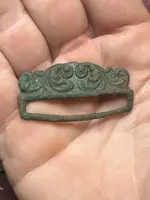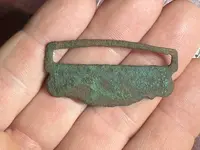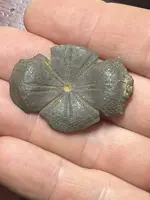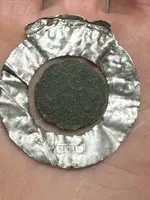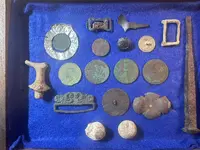Glen's Loyalists
Full Member
Now that the ground is thawed, we have been back out on the fields and have picked up a couple of interesting items:
We will start with the bucket list coin that my son got the other day, this well worn American Flying Eagle Cent. It's had a hard life, but I hear these don't tend to survive to well and it's a coin we never really expected to find, so we are both well pleased with it.


Also on the coins, he got this worn halfpenny. This came from a bit of the property that I am sure was either a carriage house or workshop. I could tell from the remains of the bust that is visible that it is another William III. This one turn out to be the oldest copper to date, 1696, that we have where the date is visible. We have older Charles II, William & Mary and French Liards, but the date is obscured on those.




Other coins found include an1815 Commercial Change Token, an 1832 Nova Scotia thistle half penny and an 1887 Canada one cent.

I was lucky to find two really nice buttons, which are among my favorite finds. First was a pewter volunteers button. I would date this to around 1800 or so. The crown looks odd to my eye for a British button, and more closely resembles the crown on a juvenile Louis IVX liard that I found. If anybody has any insight I would love to know.
The second was this really nice artillery button. Convex and made of bronze, it is in wonderful condition with a dark green patination. This button style was issued 1790-1802.


Some other nice items include what I assume is a suspender loop and what I assume is either a broach or saddle mount. The latter being brass, I believe, and quite heavy. Both are chunky I suspect they have some age to them.




Then there is this, it's made of lead pewter and is very brittle. I have no idea what it would be.


Here is an interesting find of two items from the same hole, the first being a 1920 Canada one cent and the other a bit of silver with obscured hallmarks but I believe dates to about 1900. This is at least the fourth bit of silver that I have found on the property that was just folded up and thrown away.


If things are a bit quiet I will often dig iron signals. I find it is usually easy to tell the difference between good iron and trash iron. I consider this to be good iron, this 5" spike with a flattened end, I assume to fit in between boards. It is interesting how iron that has been hammered and drawn out by a blacksmith survives so much better in the ground that standard iron. Even in this piece the end that is flattened has less corrosion than the larger end. A great object (I think).


Other bits and pieces include a dandy button, bit of pewter plate, musket balls, reins guide fragment, an older pressed metal catch and a chunky bit of bronze that I think may have come from a bell.

Yesterday a brand new Nokia The Legend detector arrived for my son and I am waiting on an upgrade for my old Deus today to convert it to a Deus II WS6 Master. I sure hope the weather cooperates this weekend.
Good luck everyone.
We will start with the bucket list coin that my son got the other day, this well worn American Flying Eagle Cent. It's had a hard life, but I hear these don't tend to survive to well and it's a coin we never really expected to find, so we are both well pleased with it.
Also on the coins, he got this worn halfpenny. This came from a bit of the property that I am sure was either a carriage house or workshop. I could tell from the remains of the bust that is visible that it is another William III. This one turn out to be the oldest copper to date, 1696, that we have where the date is visible. We have older Charles II, William & Mary and French Liards, but the date is obscured on those.
Other coins found include an1815 Commercial Change Token, an 1832 Nova Scotia thistle half penny and an 1887 Canada one cent.
I was lucky to find two really nice buttons, which are among my favorite finds. First was a pewter volunteers button. I would date this to around 1800 or so. The crown looks odd to my eye for a British button, and more closely resembles the crown on a juvenile Louis IVX liard that I found. If anybody has any insight I would love to know.
The second was this really nice artillery button. Convex and made of bronze, it is in wonderful condition with a dark green patination. This button style was issued 1790-1802.
Some other nice items include what I assume is a suspender loop and what I assume is either a broach or saddle mount. The latter being brass, I believe, and quite heavy. Both are chunky I suspect they have some age to them.
Then there is this, it's made of lead pewter and is very brittle. I have no idea what it would be.
Here is an interesting find of two items from the same hole, the first being a 1920 Canada one cent and the other a bit of silver with obscured hallmarks but I believe dates to about 1900. This is at least the fourth bit of silver that I have found on the property that was just folded up and thrown away.
If things are a bit quiet I will often dig iron signals. I find it is usually easy to tell the difference between good iron and trash iron. I consider this to be good iron, this 5" spike with a flattened end, I assume to fit in between boards. It is interesting how iron that has been hammered and drawn out by a blacksmith survives so much better in the ground that standard iron. Even in this piece the end that is flattened has less corrosion than the larger end. A great object (I think).
Other bits and pieces include a dandy button, bit of pewter plate, musket balls, reins guide fragment, an older pressed metal catch and a chunky bit of bronze that I think may have come from a bell.
Yesterday a brand new Nokia The Legend detector arrived for my son and I am waiting on an upgrade for my old Deus today to convert it to a Deus II WS6 Master. I sure hope the weather cooperates this weekend.
Good luck everyone.
Amazon Forum Fav 👍
Attachments
Upvote
22



